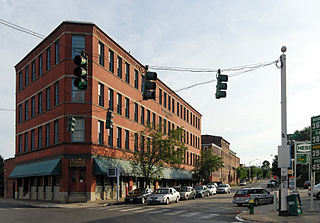
The Jewelry District is a neighborhood of Providence, Rhode Island located just south of Downtown between Interstate 195 and Henderson Street. Interstate 95 lies at the western edge of the neighborhood, which includes Davol Square and the waterfront along the west bank of the Providence River.

Carolina is a village that straddles the border of the towns of Charlestown and Richmond on the Pawcatuck River in Washington County, Rhode Island. Rhode Island Route 112 passes through the village. Carolina is identified as a census-designated place, with a population of 970 at the 2010 census.
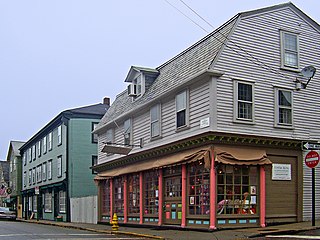
The Newport Historic District is a historic district that covers 250 acres in the center of Newport in the U.S. state of Rhode Island. It was designated a National Historic Landmark (NHL) in 1968 due to its extensive and well-preserved assortment of intact colonial buildings dating from the early and mid-18th century. Six of those buildings are themselves NHLs in their own right, including the city's oldest house and the former meeting place of the colonial and state legislatures. Newer and modern buildings coexist with the historic structures.

The Island Place Historic District is a historic district at Island Place and South Main Street at Market Square in Woonsocket, Rhode Island. The district includes six historic buildings, three of which are part of the Woonsocket Rubber Company Mill, dating from c. 1857 to c. 1919. The other buildings in the district are the Island Machine Company, the Barnai Worsted Company Dyeworks, and a wood-frame structure, that is the last surviving elements of the Wilkins Manufacturing Company. The district is bounded by Market Square, Bernon Street, and a bend in the Blackstone River. The site is now home to the Museum of Work & Culture, a project of the Rhode Island Historical Society.

Woonsocket Rubber Company Mill is an historic mill at 60-82 Main Street in Woonsocket, Rhode Island. The mill consists of a series of 3- and 4-story brick buildings built between 1865 and 1875 by Edward Harris, one of Woonsocket's leading businessmen. These buildings housed the Woonsocket Rubbert Company, one of Rhode Island's first manufacturer of rubber products, principally shoes, boots, and rubberized fabric. In 1910 the complex was purchased by the Falls Yarn Company, which used it for the production of fine woolen yarns.

St. Joseph Church is parish of the Roman Catholic Church in Cumberland, Rhode Island within the Diocese of Providence. It is known for its historic campus at 1303 Mendon Road, which includes a Gothic Revival style church along with two late 19th-century, clapboard-sheathed, wood-frame structures on the east side of Mendon Road. The church and its accompanying buildings were added to the National Register of Historic Places in 1982 as St. Joseph's Church Complex.

The Brown & Sharpe Manufacturing Company Complex is a historic factory complex in Providence, Rhode Island along the Woonasquatucket River. The 25-acre (10 ha) complex occupies most of a large city block bounded on the south by Promenade Street, the west by Bath and Calverly Streets, the north by West Park Street, and the east by Interstate 95. The complex was the longtime home of Brown & Sharpe Manufacturing Company, a manufacturer of precision equipment founded in 1833. The company was originally located in downtown Providence, but moved to this site in 1872, where it remained until 1964, when it moved to North Kingstown. Fourteen of the company's buildings survive.

The Market House is a historic three-story brick market house in Market Square, in the College Hill, a neighborhood of Providence, Rhode Island, USA. The building was constructed between 1773 and 1775 and designed by prominent local architects, Joseph Brown and Declaration of Independence signer Stephen Hopkins. The bottom floor of the house was used as a market, and the upper level was used for holding meetings. Similar buildings existed in other American cities, such as Faneuil Hall in Boston and the Old Brick Market in Newport. The building housed the Providence City Council in the decades before the completion of City Hall.
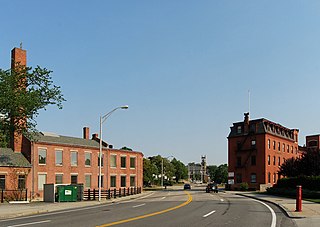
Moshassuck Square is an industrial historic district in Providence, Rhode Island, lining the banks of the Blackstone Canal just north of the Rhode Island State House. It consists of the few surviving buildings of the once-extensive American Screw Company complex, which was largely developed between the 1840s and 1870s, and was a major fixture in the Providence landscape prior to its destruction by fire in 1971. The buildings are in an area bounded by Charles Street on the west, Stevens and Hewes Streets on the north, North Main Street to the east, and Mill Street to the south. Prominent among them are the Stillman White Foundry and Fletcher Manufacturing Company office building, which stand on opposite sides of Mill Street near its crossing of the canal. At 127 Charles Street stands a three-story brick building built c. 1900 as a retail and residential building. The only surviving elements of the Screw Company complex are located at North Main and Hewes Streets, and now house the Providence Center.
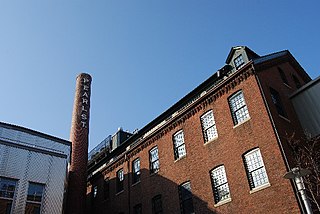
The New England Butt Company is a historic factory building at 304 Pearl Street in Providence, Rhode Island. It is a 3 1⁄2-story brick structure with a monitor roof, built in 1865 to designs by Spencer P. Read. The New England Butt Company originally manufactures cast-iron butt hinges, but later changed to producing machinery for braiding and stranding wire. Many of the machines are still used today by wire companies throughout the world.
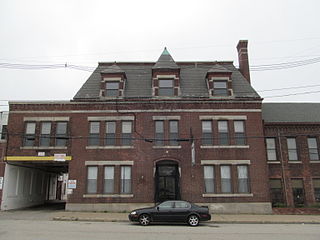
The Nicholson File Company Mill Complex is a historic industrial manufacturing complex at 1-45 Acorn Street in Providence, Rhode Island. It consists of 24 buildings occupying 7 acres (2.8 ha) of land, of which 20 are historically significant. The oldest of the buildings were built in 1865 to designs by William Nicholson, and the complex was regularly expanded over the decades through the early 20th century. The Nicholson File Company was a major producer of machine-made files, started by William Nicholson in 1859. The company manufactured precision tools used in the manufacture of armaments during the American Civil War for the Union Army, and closed the plant in 1959. It has been used by a variety of light industrial concerns since then.

The Perkins Buildings are a group of three historic industrial buildings located at 85 Sprague Street, 101 and 102 Westfield Street in Providence, Rhode Island. They were built between 1887 and 1892 by Charles H. Perkins, and were originally occupied by separate industrial tenants. Two of the buildings are brick structures built in 1892 and 1890, respectively, while the 1887 mill at 101 Westfield is a wood-frame structure, a rare 19th-century survivor in the state. These buildings were consolidated into a single industrial complex in the first half of the 20th century by the Rau Fastener Company, which operated on the premises until 1994.

The Providence Jewelry Manufacturing Historic District is a predominantly industrial historic district in Providence, Rhode Island. It covers a roughly 19-acre (7.7 ha) area just south of Downtown Providence, and was originally bounded by Interstate 195 prior to a realignment in the 2000s which reconnected the two areas. Although the area began as a residential area, and still has some houses in it, it developed in the late 19th and early 20th centuries as a center of Providence's jewelry manufacturing businesses. The oldest industrial building in the district is the 1848 Elm Street Machine Shop, a 2 1⁄2-story stone structure that now houses offices of Brown University.

St. Joseph's Roman Catholic Church is a historic church at 86 Hope Street in Providence, Rhode Island within the Diocese of Providence.

The South Street Station is an historic electrical power generation station at 360 Eddy Street in Providence, Rhode Island. It is a massive brick and stone structure, built in stages between 1912 and 1952. Despite three major phases of construction, the 58,000 square foot building has fairly consistent Classical Revival styling. The building, an excellent example of early 20th-century power plant design, burned coal to provide electrical power to the city. It was gradually taken over by the more modern Manchester Street Station, and was decommissioned in 1995.

The Hope Village Historic District is a historic rural mill settlement within Hope Village in Scituate, Rhode Island. Hope Village is located on a bend in the North Pawtuxet River in the southeastern corner of Scituate. Industrial activity has occurred in Hope Village since the mid-eighteenth century. Surviving industrial and residential buildings in the Historic District date back to the early 19th century. The village center sits at junction of Main Street and North Road. Hope Village radiates out from the center with houses on several smaller side streets in a compact configuration. Currently there is little commercial or industrial activity in Hope Village and none in the Historic District. The present stone mill building on the south side of Hope Village was built in 1844 by Brown & Ives of Providence, expanded in 1871 and modified in 1910. Approximately one quarter of the village's current housing stock was built as mill worker housing by various owners of Hope Mill.

Wyoming is a village and census-designated place on the Wood River in southern Rhode Island, primarily in the town of Richmond, Rhode Island, but extending north across the river into the town of Hopkinton, Rhode Island. The population was 270 at the 2010 census. It is the site of the Wyoming Village Historic District and a post office assigned ZIP code 02898.

Davol Square is a historic public square in central Providence, Rhode Island. It is located at the intersection of Point Street and Eddy Street in the Upper South Providence neighborhood, in the middle of the Jewelry District.

Providence is the capital and most populous city of the state of Rhode Island and is one of the oldest cities in the United States. It was founded in 1636 by Roger Williams, a Reformed Baptist theologian and religious exile from the Massachusetts Bay Colony. He named the area in honor of "God's merciful Providence" which he believed was responsible for revealing such a haven for him and his followers. The city is situated at the mouth of the Providence River at the head of Narragansett Bay.

The William J. Braitsch and Company Plant is a historic industrial building at 472 Potters Avenue in Providence, Rhode Island. Built in 1892, it played a key role in the development of the silversmithing industry in the city. It was listed on the National Register of Historic Places in 2016.






















